Introduction
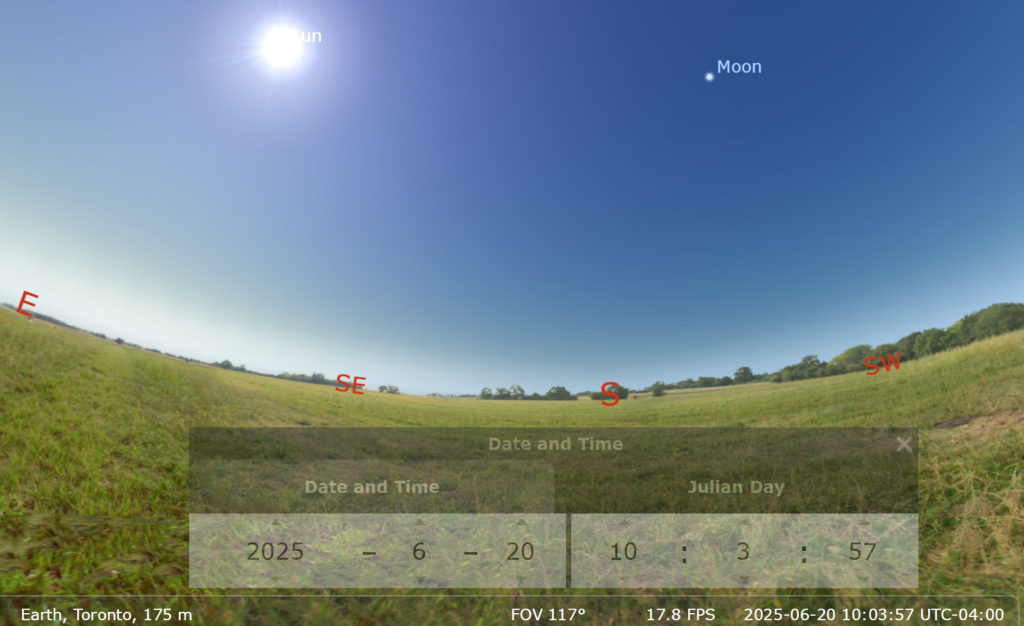
June 20th was Summer minus one day! The forecast was sun mixed with cloudy periods. I headed down to Toronto Harbourfront and the tip of Trillium Park. There is an excellent view of the Lake Ontario water horizon (Az =131deg & Az = 214deg). Figure 1 shows the Stellarium prediction for this date and time. I was able to see the Sun & Moon (waning crescent). The horizon was hazy due to fog mixed with forest fire smoke. The moon was very faint and the lower limb hard to see. I made a series of measurements and took the best of both. The purpose of the exercise was sextant practice and working with the different sight reduction methods.
Sun & Moon Measurements
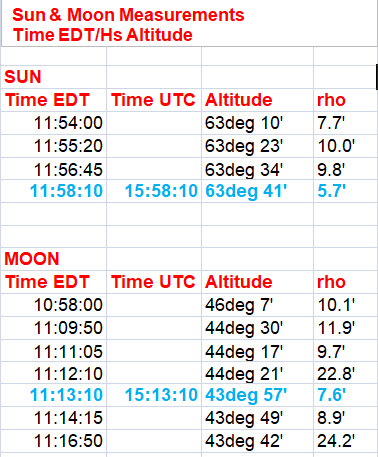
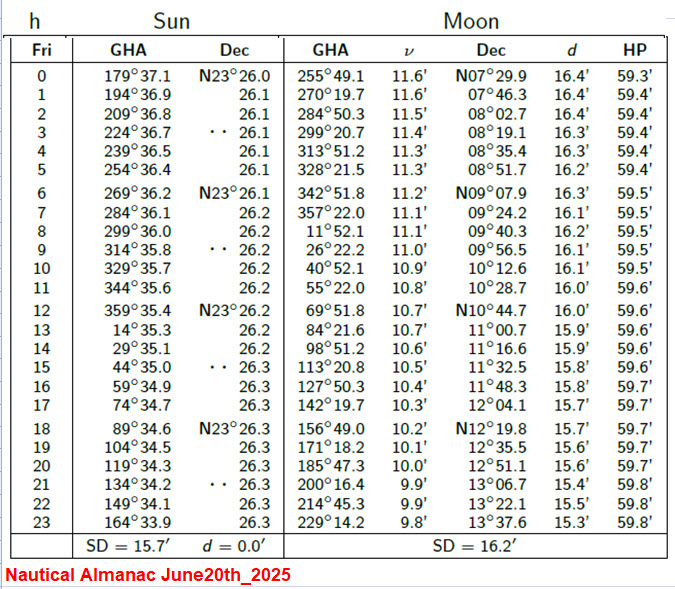
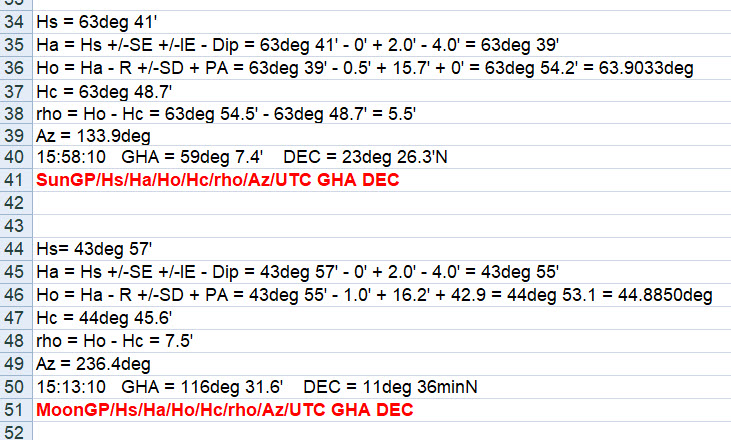
Figure 2 shows the various sightings taken and their quality (rho determined from known position). I decided to take the two best sightings to determine a fix by the various methods to compare, knowing that the result will probably be out by roughly sqrt(5.7’^2 + 7.6’^2) = 10′ approx. Figure 3 shows the Nautical Almanac page for Sun/Moon on June 20th_2025. Figure 4 shows the sight reductions Hs/Ha/Ho. GHA/DEC are determined by interpolation of the table values at 15:00 & 16:00.
ScicosLab 2Altitude Solution

Figure 5 shows the three spherical triangles formed by the Sun & Moon sightings. B is the North Pole, D is the Observer Position, A is the MoonGP and C is the SunGP. The ScicosLab solution is discussed in Ref.1/6 and shown in the solution spreadsheet Figure 12. Triangle BAC is first solved because we know two sides d1/d2 (colats_rad*Re) and contained angle B (del_GHAs). Next we solve triangle DAC, since we know 3 sides (b1=(pi/2_HoA)*Re, b2=(pi/2_HoC)*Re). Finally we solve triangle BDC (2 sides and contained angle) to get the Lat/Long of D.
NAO Solution
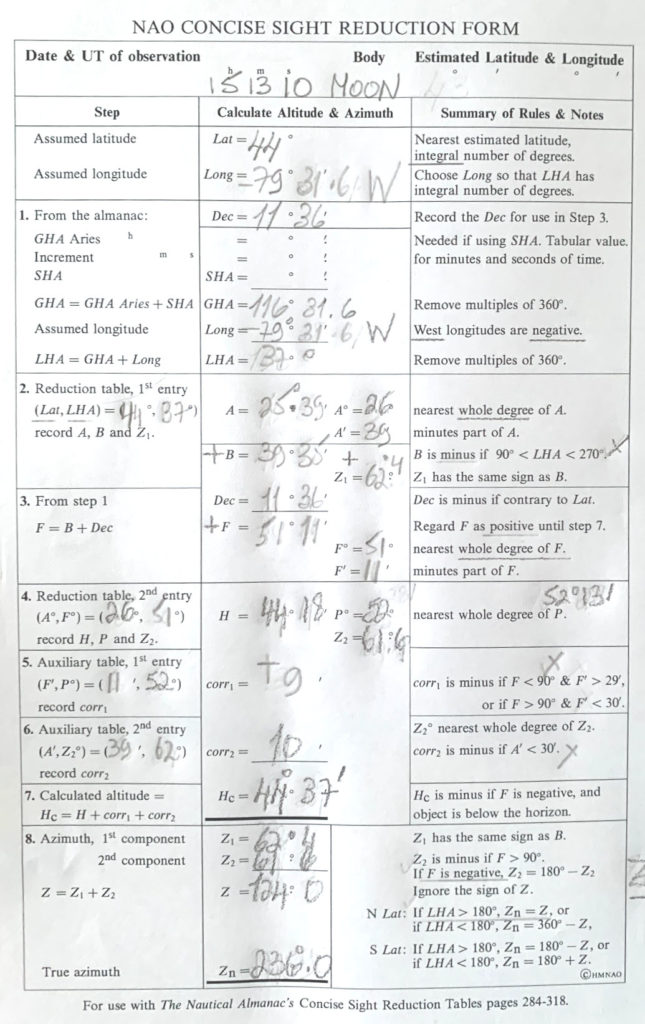
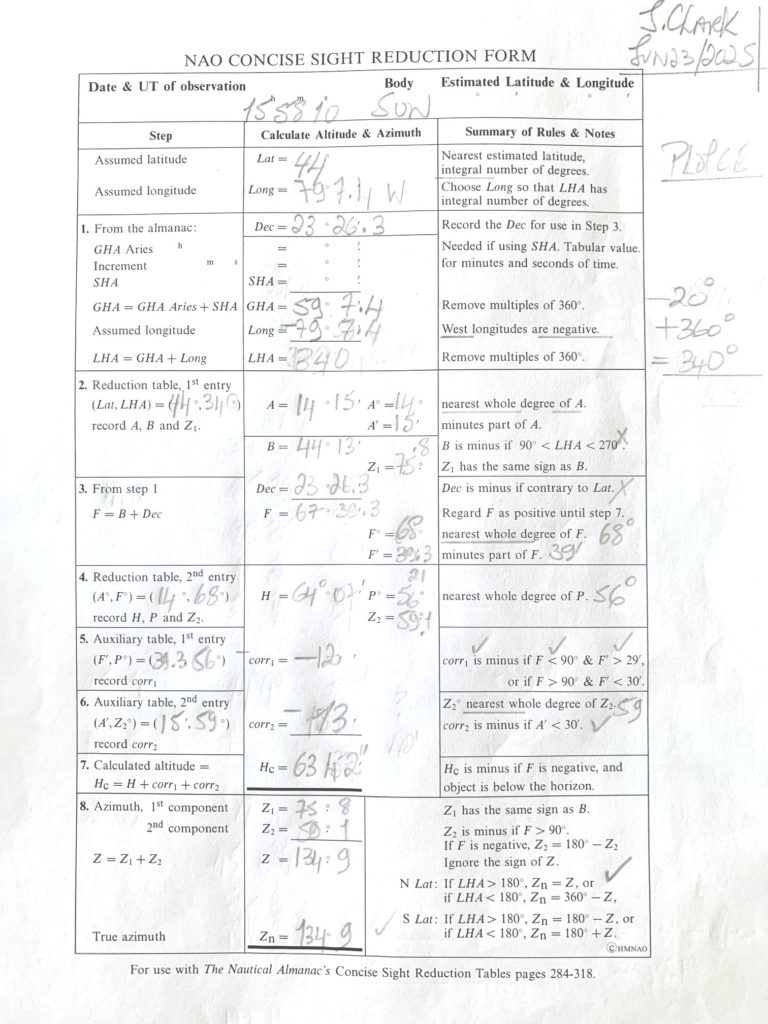
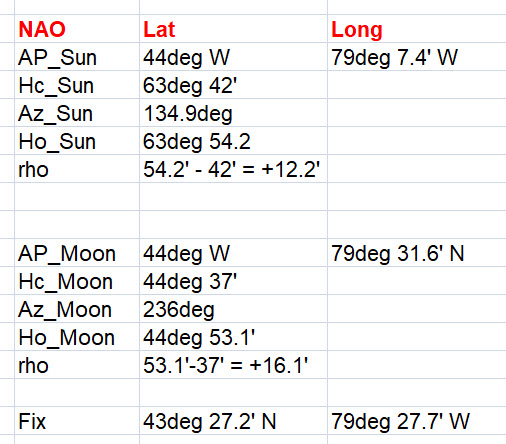
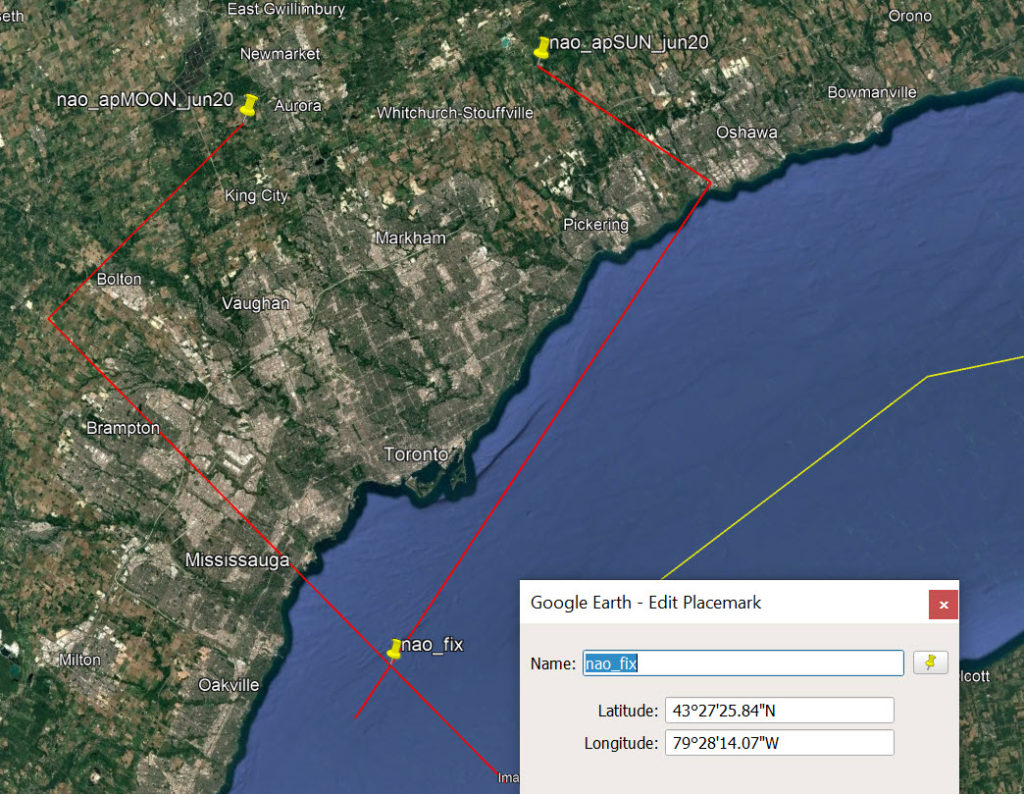
Figure 6 shows the NAO sight reduction forms for the Sun & Moon. Each has a slightly different AP_long in order to give an integral LHA. NAO uses the Marc St.Hilaire method and the intercept and azimuth calculations are shown in Figure 7. Since the intercept rho is positive in both cases, we advance along the azimuth by 12.2Nmi for the Sun (az=134.9deg) and 16.1Nmi for the Moon (az=236deg). At these two points, Sumner lines are drawn at right angles to the azimuths and their intersection gives the fix as shown in Figure 8.
AP3270 Solution
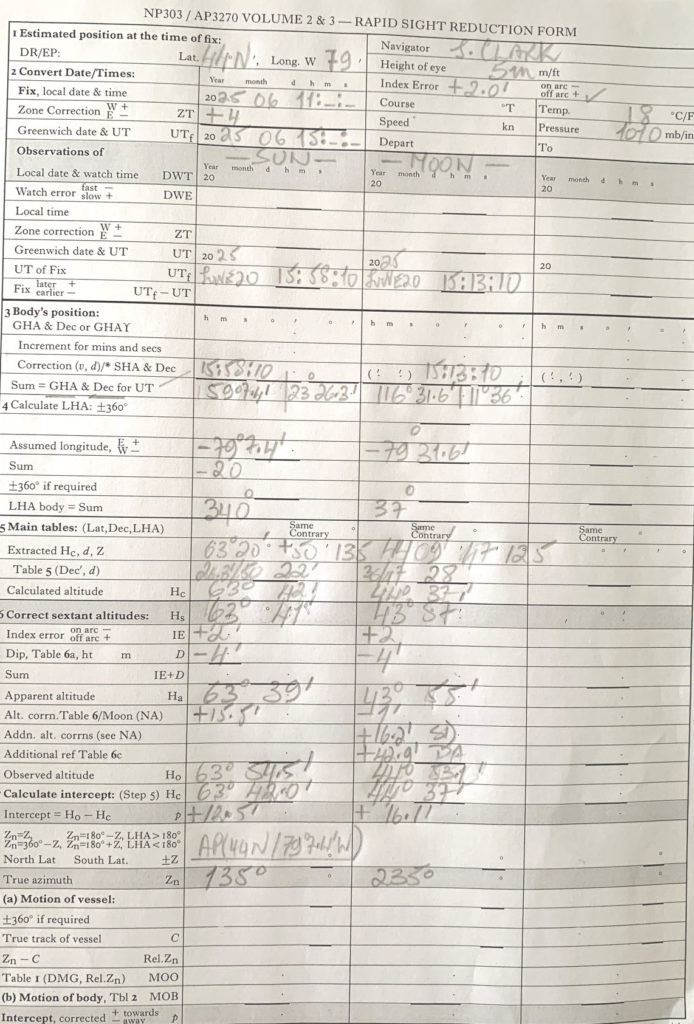
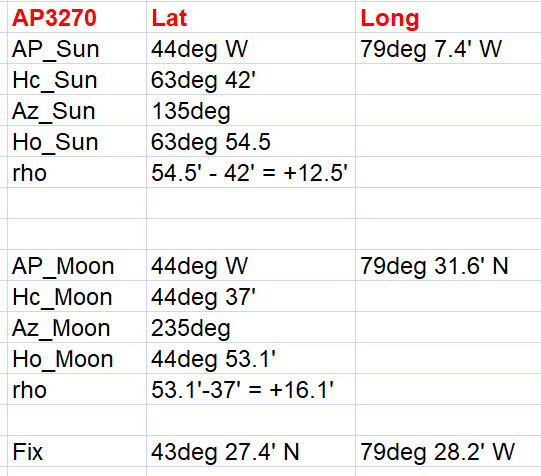
Figure 9 shows the AP3270 Sight Reduction Form. Both Sun & Moon reductions are placed on the same sheet. For convenience Lat = 44deg N is chosen for the AP lat. The AP long is adjusted as in NAO to give a whole number of degrees for the LHA. This gives the same AP as in NAO. GHA and DEC are entered as before, having been calculated using the Nautical Almanac. AP3270 tables are more extensive than NAO resulting in only two look-ups as opposed to four. The first look-up is for Lat/Dec/LHA and the second for minutes of Dec & d. Figure 10 shows the resulting calculations. Note there is virtually no difference in this case between the Marc St.Hilaire solution for NAO & AP3270.
Solution Comparisons
| Latitude | Longitude | |
| Known Position (GE/GNSS) | 43deg 37′ 39″N | 79deg 24′ 41″W |
| ScicosLab_2Altitude | 43deg 27.52’N Error = -10.13′ | 79deg 27.69’W Error = +3.0′ |
| OpenCPN/CelNavPlugIn | 43deg 27.0’N Error = -10.65′ | 79deg 27.8’W Error = +3.12′ |
| NAO (Marcq St.Hilaire) | 43deg 27.4′ N Error = -10.25 | 79deg 28.2′ W Error = +3.52 |
| AP3270 (Marcq St.Hilaire) | 43deg 27.4′ Error = -10.25′ | 79deg 28.2′ Error = +3.52′ |
| NavAlgos (Marcq St.Hilaire) | 43deg 27.2’N Error = -10.5′ | 79deg 27.7’W Error = +3.02 |
The purpose of this exercise was to get practice using the various sextant and sight reduction methods. The two sights were out due to factors discussed, but the sight reduction methods as in Figure 11 all give a very similar result which is the important thing.
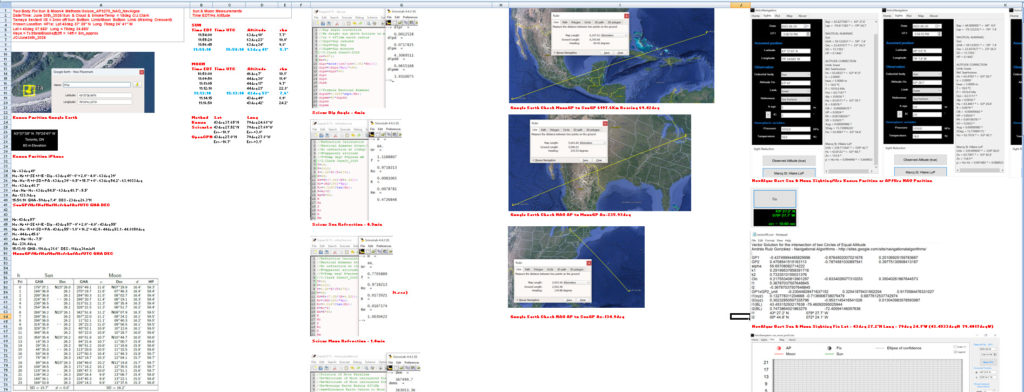
Figure 12 shows the spreadsheet showing all the sighting work involved. It can serve also as a useful placeholder for future sight reductions.
Please send your comments, questions and suggestions to:
contact:

References
#1. – “Celestial Navigation – Spring Fix”
https://jeremyclark.ca/wp/nav/celestial-navigation-spring-fix/
#2. – “Celestial Navigation Basics – Fix”
https://jeremyclark.ca/wp/nav/celestial-navigation-basics-fix/
#3. – Celestial Navigation Basics – Hc Calculated Altitude
https://jeremyclark.ca/wp/nav/celestial-navigation-basics-hc-calculated-altitude/
#4. – “Celestial Navigation Basices – Ho Observed Altitude”
https://jeremyclark.ca/wp/nav/celestial-navigation-basics-ho-observed-altitude/
#5. – “Celestial Navigation Basices – Ha Apparent Altitude”
https://jeremyclark.ca/wp/nav/celestial-navigation-basics-ha-apparent-altitude/
#6. “Celestial Navigation Basics – Hs Sextant Altitude”
https://jeremyclark.ca/wp/nav/celestial-navigation-basics-hs-sextant-altitude/
